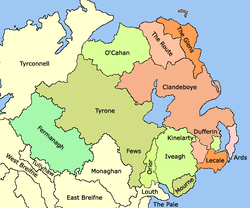Tír Eoghain
Tír Eoghain (Irish: Land of Eoghan), also known as Tyrone, was a kingdom and later earldom of Gaelic Ireland, comprising parts of present-day County Tyrone, County Armagh and County Londonderry. The kingdom represented the core homeland of the Cenél nEógain people of the Northern Uí Néill and although they ruled, there were smaller groups of other Gaels in the area. Also known as the guidance of Land. One part of the realm to the north-east broke away and expanded, becoming Clandeboye, ruled by a scion branch of the Ó Néill.
Tír Eoghain | |||||||||||
|---|---|---|---|---|---|---|---|---|---|---|---|
| 5th century – 1607 | |||||||||||
 Coat of arms
| |||||||||||
 Tyrone c. 15th–16th centuries. | |||||||||||
| Status | Túatha of Ailech (until 1185) | ||||||||||
| Common languages | Irish | ||||||||||
| Government | Elective monarchy | ||||||||||
| King / Chief | |||||||||||
• c. 465 | Eógan mac Néill (first) | ||||||||||
• 1593-1607 | Aodh Mór Ó Néill (last) | ||||||||||
| History | |||||||||||
• Established | 5th century | ||||||||||
• Disestablished | 1607 | ||||||||||
| |||||||||||
| Today part of | |||||||||||
History
From the 5th century founding of Cenél nEógain, the tuatha was a sub-unit of the larger kingdom of Ailech (which they typically held the kingship to), along with their Cenél Conaill cousins, fellow descendants of Niall of the Nine Hostages. The initial ascent of Ailech had coincided with the decline of the Ulaid, whose kingdom of Ulster receded to the north-east coast.
In the 12th century the kingdom of Ailech split into two sovereign territories and Cenél nEógain became Tír Eoghain, the land of Eoghan, Anglicised as Tyrone. It was ruled under the Meic Lochlainn clan and then under their kinsmen the Ó Néill clan. The other part of Ailech, Cenél Conaill became known as Tír Conaill, the land of Conall, Anglicised as Tyrconnell.
Following the Norman invasion of Ulster in 1177, Tír Eoghain had become the predominant power in the north of Ireland, a position it regained upon the collapse of the Norman Earldom of Ulster in the 14th century. During the reign of Tudor monarch Elizabeth I it would become an earldom within the kingdom of Ireland, however the extent and power of Tyrone would be eventually curtailed and it was shired into the counties of Armagh and Tyrone, and subdivided into baronies.
During the reign of Stuart monarch James I, Tyrone would be reduced further with the barony of Loughinsholin in its north-east being transferred to the new county of Londonderry. The Ó Néill rebelled several times, attempts to reassert sovereignty. The last attempt of substance was under Aodh Mór Ó Néill, Earl of Tyrone, who fled in 1607 in what became known as the Flight of the Earls, where he and many of his allies (particularly among Ulster Gaeldom) fled Ireland.
Kings of Tyrone
Bibliography
- Bardon, Jonathan (2005). A History of Ulster. The Blackstaff Press. ISBN 0-85640-764-X.
- Canny, Nicholas (2001). Making Ireland British, 1580-1650. OUP Oxford. ISBN 9780199259052.CS1 maint: ref=harv (link)
- Connolly, S. J. (2009). Contested Island: Ireland 1460-1630. OUP Oxford. ISBN 0199563713.CS1 maint: ref=harv (link)
- Ellis, Peter Berresford (2002). Erin's Blood Royal: The Gaelic Noble Dynasties of Ireland. Palgrave Macmillan. ISBN 0312230494.CS1 maint: ref=harv (link)
- Ó Muraíle, Nollaig (2004). The Great Book of Irish Genealogies. De Burca Books. ISBN 0946130361.CS1 maint: ref=harv (link)
- The Ancient and Royal Family of O'Neill, by Desmond O'Neill
- The Great O'Neill, by E. Boyd Barret, Hale Cushman, Flint, Boston, 1939.
- Shane O'Neill, by Ciaran Brady, Dundalk 1996